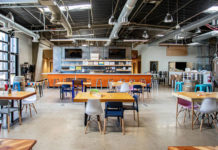It goes without saying that when building a nightclub or bar, aesthetics play an enormous role in its success. Naturally, owners want their establishment to stand apart from others and aim for a ‘look’ that will outwardly reflect its character and identity through interior design and décor.
Furnishing your nightclub or bar demands a significant portion of your overall budget and can be riddled with overspending and unforeseen costs. Taking caution to plan out your finances based on an initial design concept is imperative in ensuring that furnishing your club or bar won’t break the bank.
So how much should owners shell out to fashion a decorative scheme that suits their overall concept? “Depending on the venue,” says Chris Lenahan, Developer, VMI Ltd., Portland, Oregon, “I’d say that on the furnishings—furniture, decorations, bar top—you should spend about 40% of the budget. You’re still going to have a lot of expenses associated with that—your architect and contractors, your vendors, shipping costs, and so on.” Lenahan applies what he calls ‘value engineering’ to all of his projects. “You can actually create long-term savings by picking and choosing furnishings that are durable and are going to last,” he says.
It helps to be creative but selective with the furnishings you choose. Finding less expensive alternatives in some areas may afford you the ability to spend more in others. Lionel Ohayon of design firm ICRAVE, New York, New York, knows that just because you may have the freedom of a large budget, that does not mean you necessarily have to spend it. “You need to be creative with your money and not spend it on frivolous things,” says the architect/designer, whose firm is responsible for hot spots such as Villa Lounge in Los Angeles and the Penthouse Executive Club in New York City. At STK, a high-end bar-lounge-restaurant in New York, the main bar boasts a beautiful display of custom-made white horns protruding from its back wall, which Ohayon revealed is the original brick remaining from the parking garage which the site once was, just painted white.
“The bar itself is the first thing I would focus a budget on,” agrees Lenahan. “You need to choose something sturdy enough that will also go with the décor of the bar.” Based on the consistent abuse taken by a bar over a given period of time, he suggests building one using glue-laminated beam, an engineered wood product with comparable strength to steel. “A laminate bar top is not going to hold up,” he says. “The glue-laminated beam is a very affordable option that looks phenomenal and lasts forever.”
As nice as your bar may be, however, many of your patrons are there to relax and hang out, which sometimes requires a place to sit. Regardless of the type of business being built, both Lenahan and Ohayon agree that seating is a crucial element to the success of any bar or club. For bars catering to casual happy hours and Sunday afternoon football, standard or generic wooden bar stools and chairs will suffice. In a nightclub or lounge, however, finding cost-effective, comfortable seating that can withstand spilled drinks and stiletto heels is critical.
ModernLineFurniture.com, of Rahway, New Jersey, distributes customizable seating imported from overseas, which allows them to be sold at reduced prices since material and labor costs abroad are generally less than their U.S. counterparts. Instead of spending an exorbitant amount of money to purchase a sectional once, Will Spivak, managing partner at ModernLineFurniture.com, says that their clients prefer to spend less on a set that they can dispose of and replace easily. “It makes more sense for our clients to buy a product four or five times a year instead of one that they have to keep repairing,” he says. “Normally you’ll spend maybe $15,000 to $20,000 on furniture for your VIP lounge. With our product, you spend about $6,000 on a similar set, and you get seating for 2,500 square feet of space, plus easily replaceable parts that are always in stock.”

Some of ModernLineFurniture.com’s most popular models are its 8224VIP, a rectilinear sectional that can be rearranged into various formats, and the 8004VIP, a circular version. Both are available in multiple colors and with matching ottomans and tables. The company is currently working on developing pieces comprised of modular parts, which will eventually allow owners to replace single components, as opposed to purchasing a whole new piece.
Lenahan agrees that incorporating a product like ModernLineFurniture.com’s is a smart choice. “For a high-end lounge I would go with something more attractive and more expensive, simply because of the nature of the clientele and lack of wear-and-tear on it. But, for a nightclub or party bar, I would go with something more cost-effective and easier to replace, something that you can buy knowing a year later it will still be in stock.”
For owners concerned that furnishing their club or bar is burning a whole in their pocket, Sundry Design Solutions of Springfield, Illinois, manufactures the Chameleon bar stool and table, or what owner Dave Holland dubs “the furniture that pays you back.”
The furniture’s conical bases contain panel graphics that can be printed to display whatever design you choose, including promotions and advertisements. “You can sell the panels as ad space to your distributors, for example. All of a sudden, Budweiser and Absolut are paying you to promote their product in your bar or nightclub. It’s just another way to generate revenue,” says Holland. “I have a client who hasn’t even opened and he’s already sold ad space on nine out of the 20 stools he purchased, for more than 40% more than he paid for the lot.”
The stools and tables are manufactured using modular steel parts, and contain a rechargeable LED light bulb that lights up the base for up to 50 hours.
Although design and style are important aspects to consider when choosing how to furnish your nightclub or bar, it is important to keep in mind your projected traffic volume in order to best measure the wear and tear your furnishings are going to experience. “One of the biggest mistakes I’ve seen is owners that hire designers who usually design restaurants,” laments Lenahan. “Those designers don’t necessarily understand the abuse a bar takes, and they always end up choosing fabrics and furnishings and flooring that cannot handle the rigors of a bars use. For example, they’ll choose cloth instead of vinyl or leather, and drinks spill, soak in and get sticky and smell and never come out.”
Aside from the seating, the flooring in your space is inherently susceptible to the most damage with the least attention paid to it by customers. The material you choose for flooring should be durable and strong, but not so hard that it makes standing for long periods of time uncomfortable. While some bars or clubs install separate dance floors that may feature lighting or special effects, generally speaking you will want your flooring to stay simple for the sake of cleaning and maintenance.
Although hardwood floors are soft and more comfortable for people to stand on through the night, Lenahan warns against the associated costs, as they require constant upkeep. Instead, he advises you opt for a more industrial material. “Your first choice should always be stamped and stained concrete flooring for aesthetics and for keeping it clean and looking nice for a long period of time,” he says. “A carpet is the worst, although in some cases it can offer the illusion of warmth, comfort and poshness. Sometimes I’ll include them in VIP areas—maybe 300 to 400 square feet of space—but you’ll have to consistently maintain that area with steam cleaning.”
Regardless of how much money you dedicate to furnishing your bar or club, both Lenahan and Ohayon are quick to point out some of the most common mistakes owners can make. “For everyone to maintain their concept, to have their own style and vibe, it’s easy to get lost and people sometimes try to do too much,” warns Lenahan. “And if you don’t go far enough, it’s a confused concept. People are capable of losing their vision and running out of money,” warns Lenahan.
“Remember that you’re redesigning a night out for your clients,” says Ohayon, offering a solution on how to bring a concept to fruition. “Most people make the mistake of designing their place for themselves, but they’re usually in the wrong.”








